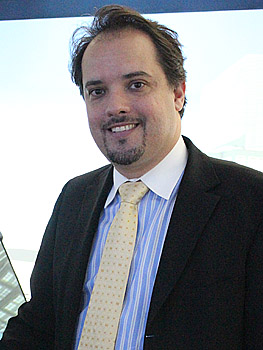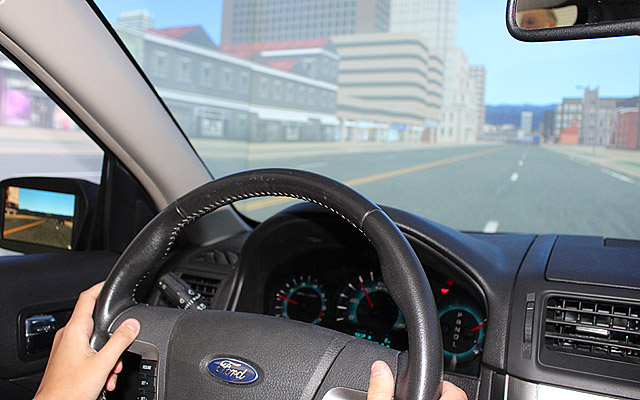
Simulator Evaluates How Eye Diseases Affect Driving
Published Date
By:
- Scott LaFee
Share This:
Article Content
The University of California, San Diego School of Medicine is the first ophthalmology department in the nation to feature a fully dedicated high-fidelity, highly realistic driving simulator for evaluating the effects of visual impairment on a person’s driving performance.
Located in the UC San Diego Shiley Eye Center’s new Visual Performance Laboratory, the simulator occupies an entire room. Drivers sit in an actual Ford Fusion cabin mounted on a motion platform and look out onto a realistic cityscape with road and traffic projected on large-screen panels covering a 180-degree field of view. The scenes interactively respond to the driver’s changes in direction and speed.
The car pitches, rolls and rumbles in response to acceleration, braking and road conditions. The three adjustable rear-view mirrors display images of what would be visible behind the vehicle.

Felipe Medeiros, MD, PhD
Felipe A. Medeiros, MD, PhD, professor of ophthalmology and the Ben and Wanda Hildyard Chair for Diseases of the Eye, and colleagues plan to use the simulator to investigate how eye diseases, such as glaucoma and age-related macular degeneration, alter a person’s visual performance and ability to drive well and safely.
Glaucoma is the leading cause of irreversible blindness and visual impairment in the world, and it is believed that people with glaucoma are more likely to be involved in motor vehicle accidents.
“We know that standard visual acuity or visual field tests may not provide enough information to evaluate whether a person is capable of driving safely,” Medeiros said. “The driving simulator will allow us to assess visual performance in a realistic and demanding scenario, providing a much better evaluation of the impact of eye diseases on driving fitness.”
Among the notable advantages of the simulator is that driving skills can be tested under conditions that would be too dangerous to test in reality. With the simulator, for example, it is possible to keep track of a driver’s ability to maintain lane position, follow behind another car on a windy road, negotiate a curve and detect and avoid hazards, such as pedestrians crossing a street. The simulator can also recreate night driving and driving in heavy fog.
In addition, the simulator can be used to measure changes over time, to better understand the progression of different eye conditions and their impact on visual performance and driving.
“One of the purposes of the simulator is to try to better evaluate and determine who is at higher risk for becoming impaired in their ability to perform everyday tasks,” said Medeiros. “Those at higher risk may need to be treated more aggressively, whereas those at lower risk may be treated more conservatively.”
The first patients to use the simulator will be participants in an on-going, long-term National Institutes of Health study on eye diseases, headed by Medeiros with co-investigators Peter Rosen, MD, associate clinical professor; Robert Weinreb, MD, chairman and Distinguished Professor of Ophthalmology and the Morris Gleich, MD, Chair of Glaucoma, and Linda Zangwill, PhD, professor of ophthalmology-in-residence.
These patients have already had their visual and driving performances evaluated on a smaller, lower fidelity version of the stimulator. Researchers have used this data to identify components of computer driving scores that are most predictive of a person’s history of collisions, as recorded by the California Department of Motor Vehicles.
“The research will now be expanded with the use of the new simulator, allowing us to test a much larger number of hypotheses in more realistic scenarios,” Medeiros said. “There are people who are driving who should not be and there are people who aren’t driving but could safely. The research on the new driving simulator will help us identify those at higher risk for being involved in crashes and provide better guidance to patients and interested parties”.
The scientists hope to also use the simulator to train drivers in how to compensate for skills diminished by age or disease. “There is evidence suggesting that about 50 percent of motor vehicle collisions are caused by deficits in the ability to process visual information and allocate attention while driving,” Medeiros said. “We may be able to train people to get better on how to perform these tasks.”
Funding for the project comes, in part, from the National Eye Institute (grant EY021818).
Share This:
You May Also Like
Stay in the Know
Keep up with all the latest from UC San Diego. Subscribe to the newsletter today.



